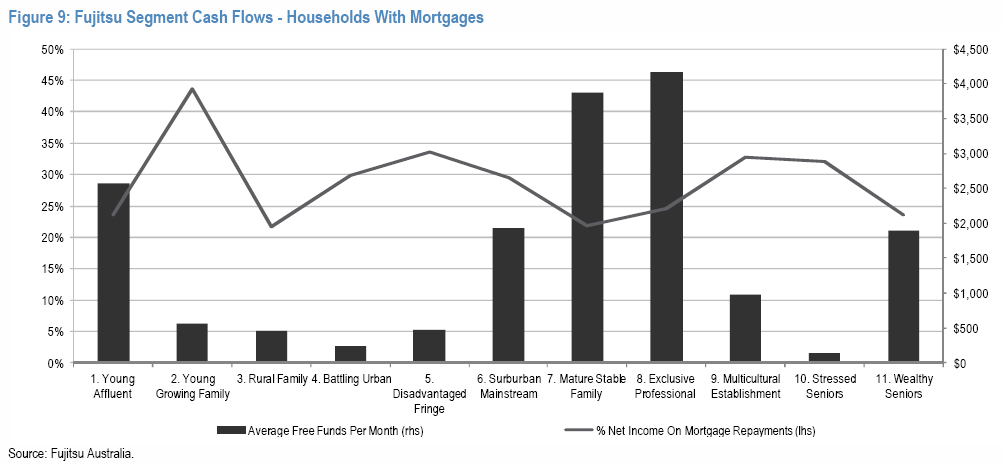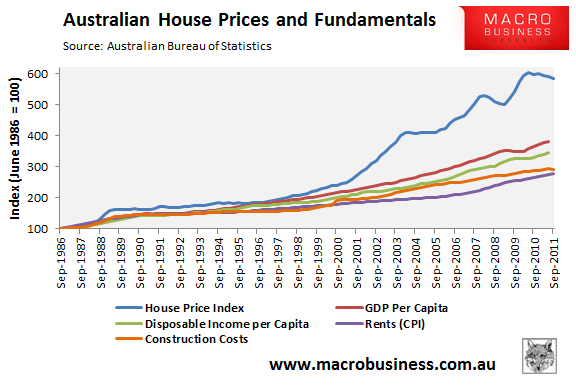
You’re no doubt more used hearing from Fujitsu about air conditioners. But it’s a little known fact that they run a small financial services consulting unit which today, in conjunction with J.P. Morgan, released a pretty bearish assessment of the prospects for Australian housing.
The semi regular Australian Mortgage Industry report concludes:
…that the biggest driver of housing credit growth in the 15 year period between 1992 and 2006 was more households taking on debt as they adjusted to lower interest rates. This dynamic accounted for nearly half the average 15.2% p.a. housing credit growth during the period with income growth (3.9% p.a.) and higher gearing tolerance (3.9% p.a.) much less significant. From 2007 onwards, despite income growth accounting for ~4% p.a. housing credit growth, the proportion of new households taking on debt has more than halved to 3.3% p.a. and higher gearing tolerance is absent (and actually negative in the last two years).
Looking forward through 2012 and beyond, we note that the recent re-calibration of risk settings (by borrowers, lenders and regulators) means it is unlikely these historical drivers will re-emerge to drive housing credit growth beyond ‘mid-single digits’ in the short to medium term. Going forward, we expect future housing credit growth to reflect fundamental factors, including normalised LVR’s, modest investor housing credit growth and tighter, more expensive funding for commercial real estate purposes, which will keep new housing starts under pressure.
A structural shift in other words. Exactly right.
The strength of this report is its detailed assessment of the various demographic cohorts that drove the expansion of credit and the fading prospects of them continuing to do so:

This report is a must read. We’ll have more on it in the next few days.
Presumably by coincidence, ANZ also released a new housing report today drawing the opposite conclusion that:
A pro-active policy response in the wake of the global financial crisis provided significant support to the Australian housing market and arguably pushed house prices above ‘fair’ value. The removal/reversal of explicit policy support in 2010 combined with a sharp rise in mortgage rates saw house prices partially retrace earlier gains. Nonetheless, unlike many developed economies (US, Ireland, Spain etc), Australian house prices remain significantly above pre-crisis levels. A combination of moderate declines in price, lower mortgage rates and rising household incomes has returned prices to ‘reasonable value’. Tightening fundamentals and improved affordability should see the market find a floor in 2012.
…While we expect prices to ease further in 2012, we maintain a cautiously optimistic medium term house
price view supported by a robust economic outlook, low unemployment, falling mortgage rates, improved affordability and a further tightening of the housing demand/supply balance.
Interesting that the two reports use the identical language and reasoning for the run up in house prices. I always find this rationale a little bizarre. After all, all bubbles are underpinned by a departure from trend in credit growth. My own view is it is quite reasonable to posit that until perhaps 98/99 the run up in house prices could be justified. Not by the falling price of credit mind you, but by a powerful near decade run in productivity gains, which raised incomes and the standard of living.
Beyond that period we really entered bubble territory, helped along by some very short-sighted tax changes by the Howard government in 1999. The income growth since then has been the result of that bubble, as well as the wonders of the terms of trade. So to my mind the ANZ argument about income growth justifying house prices is circular. The following chart from the Unconventional Economist says it all:

Moreover, the housing shortage argument also assumes its own conclusion given it rests on the assumption that demand for housing is fixed. That is, it couldn’t possibly fall, even if population were to grow faster than supply, which is absurd. If housing stays on the nose long enough, and income growth is limited, then more people will live together.
So, to my mind, even though the two reports use the same frame of reference, one is more solidly argued.

